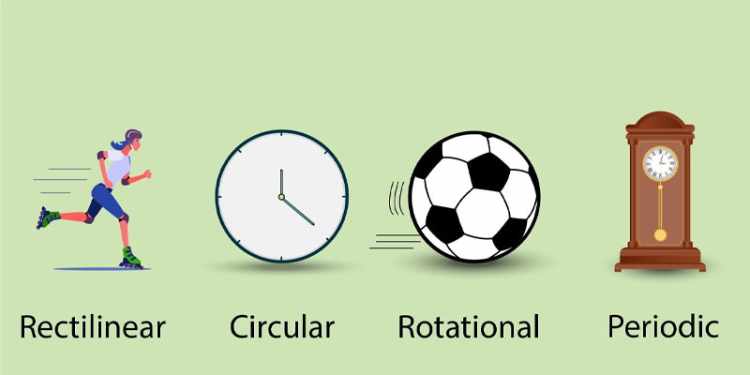Motion means the action or process of moving or being moved. Anything that moves around us is said to be in motion. So, when you put effort to make anything move, like a table, then the table is in motion. Additionally, you are also in motion since you are moving along with the table to take it from point A to point B.
In our day to day life, we find so many things moving, some at a slow pace and some at a fast pace. A few simple examples would be vehicles moving on the road, people walking on the streets, birds flying in the sky etc. Even our earth and the planets in the solar system also undergo motion since they consistently revolve around the sun.
Before getting to know the motion formula and its principle, get familiarised with the concept of motion.
Definition of motion
Motion is a change in position compared to a place and an object that is not moving. The objector place that does not move or change is the point of reference. An object or person derives its motion from speed and velocity, wherein speed signifies how fast an object is moving.
The formula of motion comes from speed which can be measured by the distance the object travels divided by the time taken to travel that distance. For example, a scooter that travels at 40 miles in an hour has a speed of 40 miles per hour. Speed in a certain direction is velocity.
When a car moves from Place A to place B, there is a change in position throughout the path with time. We observe the change in position of the car and the time too. Hence the change in position with time is what we call motion. Whenever there is a change in the position of the body from its original position, we can say that it either is undergoing or has undergone motion.
Objects such as trees, buildings etc., are said to be stationary because they do not change position. But if we consider there are stationary objects from our perspective, they are not in motion. But if an astronaut were to see the earth, all these things too are moving because the earth is moving.
Hence, all objects on the moving object are also moving. This is called the inertial form of reference. So the feeling of things in motion or stationary exists because motion is relative.
Types of motion
Motion can be of the following 7 types:
1. Rectilinear motion:
Notice the word line in the word rectilinear. We define this type of motion as a straight line that falls under the translatory motion category. For example, when a car travels in a straight line on a straight road, it performs the rectilinear motion.
Let us look at another scenario. Assume you are sitting on a railway platform, and you see the train moving. For you, the train and the passengers travelling in that train are in motion.
However, their co-passengers are all at rest or not in motion for the passengers inside the train. So for the observer sitting on the platform, the train and the people sitting inside the train are in motion. This tells us that the motion of any object is relative to the observer. Hence for different observers, the motion will be different.
2. Circular motion:
If an object moves on a circular path, it is in circular motion under translatory motion. This motion is along the circumference of a circle. So if an object is going around the circumference of a circle, we say it is undergoing circular motion. A satellite orbiting the earth at a certain height is also undergoing circular motion. Let us look at some examples of this type of motion.
3. Rotational Motion:
If we consider a particular point of the blade of a fan, that point is in a circular motion. But the entire fan considered as one single object is not moving anywhere away from its position. Hence, this is rotational motion where the fan is spinning around the axel (the rod that holds the fan), with the axel being constant.
Therefore, we understand rotational motion as a motion of a body around a fixed line. This fixed line is called the axis of rotation.
Some more examples are a merry-go-round, a spinning top, a wheel rotating around the axel, the earth spinning around its axis. Please note that the axis is passing through the body of the object. Hence it is a part of the object.
4. Curvilinear motion:
When many kids playing with a ball throw it in the air across the playground, the ball does not travel in a straight line; it takes a curve. This type of motion is called curvilinear motion, in which a body travels in a curved path.
5. Oscillatory motion:
When an object moves back and forth from a suspended point, it is oscillatory motion. A few examples are kids swinging on a swing where they move, the pendulum of a lock.
6. Vibratory motion:
If the rate of oscillation increases rapidly, such as strumming of a guitar or any other stringed instrument and even drums. These are performing a vibratory motion. Hence, vibratory motion is defined as back and forth or to and fro of an object from its mean position.
7. Periodic motion:
When a body repeats its motion after regular or constant intervals of time, it is said to have periodic motion such as the hands of a clock, earth reliving around the sun and Halley’s comet, which is seen only once in every 76 years. Periodic motion is also called a uniform motion because it travels equal time intervals at a constant speed.
Conclusion
To sum up, motion is categorised into three broad categories. Firstly, Translatory motion is where an object travels in a straight line or curved path. Secondly, Rotatory motion is where an object travels along a circle’s circumference, and thirdly, vibratory motion is where the object moves back and forth.









